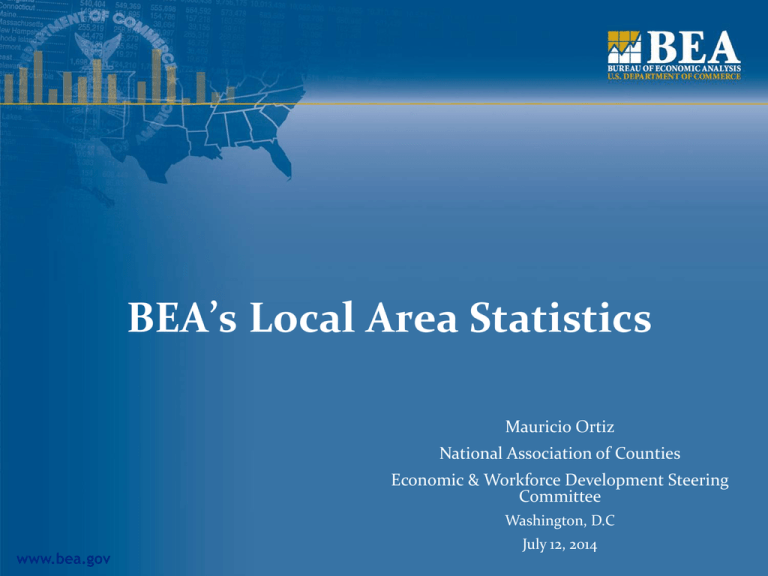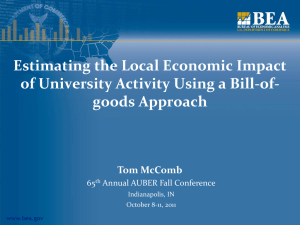BEA Local Area Statistics - National Association of Counties
advertisement

BEA’s Local Area Statistics Mauricio Ortiz National Association of Counties Economic & Workforce Development Steering Committee Washington, D.C www.bea.gov July 12, 2014 Value of Government Data ▪ Reliable information is critical to the proper functioning of an economy. ▪ Government data, Federal Statistics in particular, are an important component of the information infrastructure. ▪ “Data are the fuel that powers the 21st century economy” Commerce Secretary Penny Pritzker. www.bea.gov 2 Uses of Data ▪ Statistics provide the framework to assess an area’s economy Place of work industry data provide indirect measure of industrial market Place of residence income provides measure of consumer market Per capital personal income is an indicator of economic well-being Income component data provides socioeconomic characteristics www.bea.gov 3 LAPI Tables www.bea.gov 4 Personal Income www.bea.gov 5 Non-Labor Income ▪ Consists of dividend, interest, and rent plus personal current transfer receipts. ▪ In 2012 U.S. non-labor income is 31% of personal income. In 1970 it was 21%. ▪ Across all counties in 2012 the ratio of non-labor income to personal income ranged from 13% to 71%. www.bea.gov 6 Property Income ▪ In 2012 U.S. property income is 18% of personal income. In 1970 it was 15%. ▪ Across all counties in 2012 the ratio of property income to personal income ranged from 8% to 53%. ▪ In 1970 the ratio across all counties ranged from 2% to 53%. www.bea.gov 7 Transfer Receipts www.bea.gov 8 Current Personal Transfer Receipts ▪ In 2012 U.S social security benefits are 6% of personal income. In 1970 they were 5%. ▪ Across all counties in 2012 the ratio of social security benefits to personal income ranged from 1% to 23%. In 1970 it ranged from less than 1% to 13%. www.bea.gov 9 Current Personal Transfer Receipts ▪ In 2012 U.S Medicare benefits are 4% of personal income. In 1970 they were 1%. ▪ Across all counties in 2012 the ratio of social security benefits to personal income ranged from 1% to 16%. In 1970 it ranged from less than 1% to 4%. www.bea.gov 10 Employment by Industry www.bea.gov 11 BEA Regional Income & Product Account Estimates Used to Distribute $ 308.0 Billion in Federal Funds, FY2013 [Funded Programs Are Shown in Millions of Dollars] National School Lunch Program $11,463.3 Children's Health Insurance Program $10,027.0 Foster Care_Title IV-E $4,400.0 Rehabilitation Services_Vocational Rehabilitation Grants to States $3,191.7 Other programs $1,879.1 Title I Grants to Local Educational Agencies $3,116.8 Career and Technical Education -- Basic Grants to States $1,003.4 Block Grants for Prevention and Treatment of Substance Abuse $1,600.2 Child Care and Development Block Grant $2,190.7 Medical Assistance Program $263,700.0 All Other Funding $44,281.9 bea.gov Adoption Assistance $2,500.0 Child Care Mandatory and Matching Funds of the Child Care and Development Fund $2,909.7 Sources: Catalog of Federal Domestic Assistance (5/22/2014), 2014 President’s Budget, Appalachian Regional Commission, Department of Agriculture, Department of Commerce, Department of Education, Department of Health and Human Services, Department of Homeland Security, Department of interior. Release Schedule ▪ State Personal Income and Employment Quarterly and Preliminary Annual income by sector--3 months after end of quarter Annual income and employment by subsector--9 months after end of year ▪ Local Area Personal Income and Employment Annual only—11 months after end of year www.bea.gov 13 Questions ▪ Contact Information: Mauricio Ortiz Regional Income Division mauricio.ortiz@bea.gov 202-606-9269 www.bea.gov






